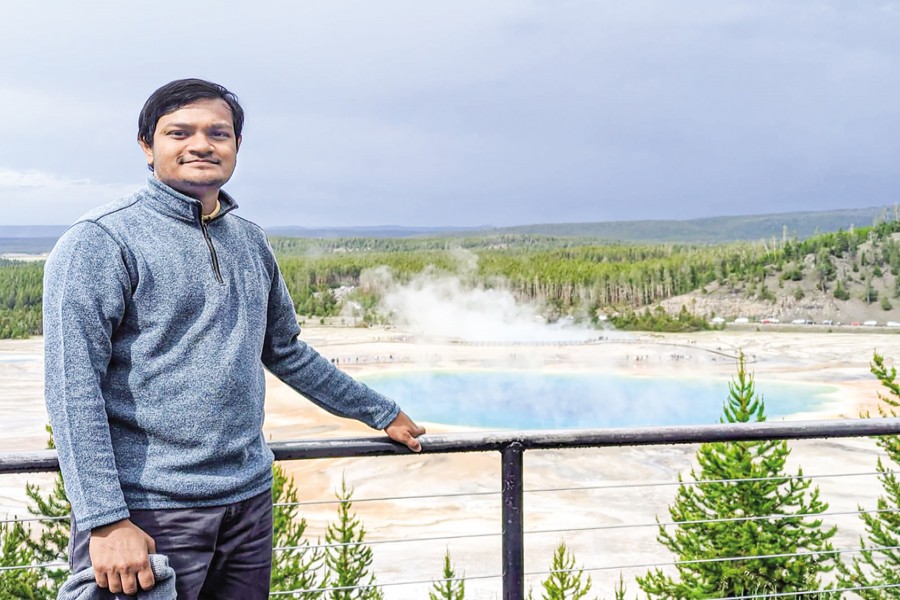From Savar to Nebraska
A Bangladeshi physicist at the frontier of quantum science

Published :
Updated :

When Nature, the world’s most prestigious science journal, published a paper by a young Bangladeshi physicist in August 2024, it marked more than an academic milestone. It showed that the frontiers of quantum materials research now extend far beyond elite Western laboratories, encompassing the journey of a student from Jahangirnagar University who reached the cutting edge of research in the United States.
That physicist is Naafis Ahnaf Shahed, a doctoral researcher at the University of Nebraska–Lincoln (UNL), whose pioneering work on twisted quantum oxides has drawn international attention for its implications in spintronics and low-power computing.
TWISTING ATOMS TO CONTROL MAGNETISM
Mr Shahed’s paper, titled “Twist-assisted all-antiferromagnetic tunnel junction in the atomic limit,” appeared in Nature on August 14, 2024. Conducted in collaboration with Professor Stuart Parkin and scientists at the Max Planck Institute of Microstructure Physics (Germany), the study introduces a new method for controlling magnetism and electronic behaviour on the atomic scale.
In simple terms, Mr Shahed and his collaborators discovered that twisting two atomically thin antiferromagnetic oxide layers can create new forms of magnetic and electronic coupling, without relying on traditional ferromagnets. This concept of “twist engineering” opens a pathway toward faster, smaller, and more energy-efficient quantum devices. The discovery helped establish a new research direction in condensed matter physics known as antiferromagnetic twistronics, an emerging field that merges geometry, magnetism, and quantum mechanics to design next-generation materials for information technologies.
LAYING THE GROUNDWORK FOR FUTURE DISCOVERIES
The Nature paper was succeeded by Mr Shahed’s earlier theoretical work on twisted oxide systems, which culminated in a Physical Review B publication in May 2025, titled “Prediction of polarization vortices, charge modulation, flat bands, and moiré magnetism in twisted oxide bilayers.”
That study predicted how twisting oxide heterostructures could give rise to exotic quantum patterns — from charge ripples to vortex-like polarization textures. The insights from this work played a crucial role in shaping a broader research direction at UNL, ultimately contributing to the successful award of a US$2.0 million NSF DMREF (Designing Materials to Revolutionize and Engineer our Future) grant starting in October 2025.
A MAJOR U.S. INITIATIVE AND A CENTRAL ROLE
The NSF DMREF project, led by Professor Evgeny Tsymbal, represents Nebraska’s first-ever DMREF award. The initiative, aligned with the U.S. Materials Genome Initiative, unites physicists, data scientists, and engineers to accelerate materials discovery through theory, computation, and machine learning.
As a core computational researcher in the project, Shahed focuses on twisted oxide heterostructures, topology, and magnetoelectric coupling, using advanced density functional theory (DFT) and Green’s function–based modeling. His work underpins efforts to understand how moiré geometry can be used to tune magnetism and polarisation at the atomic scale.

Bangladeshi physicist Naafis Ahnaf Shahed with Prof Evgeny Tsymbal of University of Nebraska-Lincoln
His results have been highlighted by UNL’s Office of Research Communications, a distinction reserved for the university’s most impactful scientific contributions.
FROM SAVAR TO NEBRASKA
Before beginning his PhD in the United States, Shahed earned both his BSc and MSc in Physics from Jahangirnagar University, graduating with a CGPA of 3.96. He later taught at Daffodil International University, and mentored graduate physics students at Jahangirnagar University before pursuing doctoral studies abroad.
At UNL’s Tsymbal Research Group, he focuses on quantum phenomena in oxide heterostructures using first-principles simulations. His growing list of publications includes Nature, Physical Review B, Advanced Materials, and ACS Nano. As of October 2025, his research has been cited over 175 times, with an h-index of 8, a strong record for a researcher still early in his PhD journey. He expects to complete his degree by Fall 2026.
‘WE’RE ON THE VERGE OF A QUANTUM AGE’
Speaking to The Financial Express, Shahed reflected on the significance of his Nature paper, “We found that twisting two atomically thin oxide layers can drastically alter how electrons and spins interact across them, allowing atomic-scale control of magnetic and electronic states. This could pave the way for much faster and more energy-efficient electronics.
Reflecting on his academic roots, he added, “Being part of Professor Dr Farid Ahmed’s condensed matter group at Jahangirnagar University gave me a strong foundation in physics and the curiosity to ask deeper questions. We didn’t have advanced equipment or powerful computers, but our group’s drive to explore and publish kept us motivated. That mindset still guides my work in Nebraska.”
Looking ahead, Mr Shahed believes quantum materials will redefine technology, saying, “We’re entering an era where quantum and spintronic materials are rapidly transitioning from theory to technology. My goal is to deepen the fundamental understanding that will make these systems practical and scalable. We’re truly on the verge of a quantum age — one that will look very different from the silicon era we’ve known for decades.”
INSPIRING THE NEXT GENERATION
To young science students in Bangladesh, Mr Shahed offers a message grounded in experience: “Stay curious and don’t give up easily. Grades matter, but they’re not everything — a perfect CGPA can’t replace creativity or curiosity. Getting stuck or failing is part of science. Build a strong base in quantum mechanics, math, and coding, because quantum materials are the future. Researchers from Bangladesh have an important role to play in shaping that future.”
Now, Naafis Ahnaf Shahed serves as a Graduate Research Assistant in the Department of Physics and Astronomy at the University of Nebraska–Lincoln, working under Professor Evgeny Tsymbal. His wife, Farzana Nazneen, also a graduate of Jahangirnagar University’s Department of Physics, is pursuing postgraduate studies alongside him. Mr Shahed’s father, Professor Dr Md Shahedur Rashid, is the chairman of the Department of Geography and Environment at Jahangirnagar University.
As Mr Shahed continues to twist atomic layers to uncover new quantum frontiers, he stands as a symbol of Bangladesh’s quiet scientific excellence, proof that curiosity, persistence, and vision can take a young physicist from Savar to the pages of Nature.
skshamimbdasia@gmail.com


 For all latest news, follow The Financial Express Google News channel.
For all latest news, follow The Financial Express Google News channel.